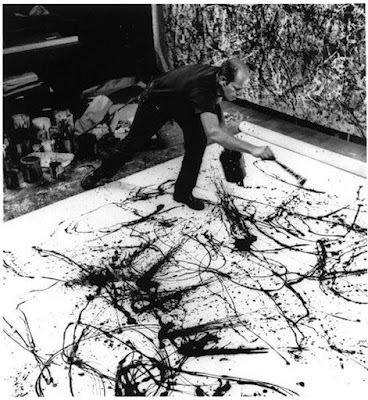PAINTERLINESS: BEAUTY IN ABSTRACTION
One of my favourite aspects of abstract painting is the ‘painterly’ quality that is characteristic of some of the earlier abstract art movements in Canada, especially les automatistes. ‘Painterly’ can be defined broadly as being “characterized by qualities of colour, stroke, or texture perceived as distinctive to the art form of painting, especially the rendering of forms and images in terms of colour or tonal relations rather than of contour or line.” Les Automatistes, such as Paul-Emile Borduas, Jean-Paul Riopelle or Marcelle Ferron, impress me through their uncanny ability to harmonize pure texture and colour without representation. This mastery of composition makes for delicious eye candy. I could stare at segments of a Riopelle or Borduas canvas for ages, as the paintings are visually sumptuous with their build up of ridges, craters, troughs, canyons, clumps, chunks and mountains of paint with more than satisfactorily aesthetic colour combinations.
Paul-Emile Borduas Composition in Black and White 1956 oil on canvas and three details of paint (Past highlight sold at Masters Gallery)
Jean-Paul Riopelle Ragale 1957 oil on canvas (Past highlight sold at Masters Gallery)
Marcelle Ferron Ombre et voyage 1962 oil on canvas (Past highlight sold at Masters Gallery)
There is thought-provoking purpose and reasoning behind the creation of these ‘automatic’ and spontaneous works of art, but more often than not I find myself casting aside inner meaning in favour of simply enjoying the visual appeal of automatiste paintings. I marvel at these artists' ability to make harmonious compositions in a “wow how did they do that” sort of way, not unlike I would for the trapeze act in Cirque du Soleil! I often fret that I do not approach the work of Canada’s modern abstract art movements with enough intellectual insight. However, perhaps my love of the ‘painterliness’ of Riopelle or Borduas' work suggests otherwise. In fact, the term ‘painterly’ or ‘painterliness’ (or even post-painterly abstraction) actually is a source of intellectual discussion regarding the type of spontaneous and non-premeditated art that les automatistes, abstract expressionists, or tachisme artists engaged in.
Jean-Paul Riopelle Bourasque 1956 and Folatre 1957 oil on canvases (Past highlights sold at Masters Gallery)
Marcelle Ferron Abstract Composition 1960 oil on canvas (Past highlight sold at Masters Gallery)
The renowned and influential art critic Clement Greenberg referred to ‘painterly’ as being “painting built-up of the strokes and streaks left behind by the movements of the brush or knife.” Greenberg’s awareness of ‘painterly’ qualities in non-representational art led him to coin the term ‘post-painterly abstraction’ in reference to the following wave of abstract art that moved away from expressionism’s impulsive placement of texture and colour in paint.
Jean-Paul Riopelle Bleury 1957 oil on canvas (Past highlight sold at Masters Gallery)
Frank Stella (American) Harran II 1967 (Post-Painterly Abstraction)
Greenberg was not the first to utilize the term ‘painterly'; it can even be applied to earlier movements of representational art such as impressionism. The term is derivative of the German concept of ‘malerisch’ (painterly) which classifies painting that is “opposite of linear, plastic or formed linear design.” The term was disseminated by Swiss art historian Heinrich Wolfflin (d. 1945)
Armand Guillaumin (French)Moret-sur-Loing 1902 oil on canvas (Collection of the Tate Gallery, London)(example of painterly strokes in impressionism)
Willem Heda (Dutch, 1593-1680) Breakfast Piece Still Life (example of painting formed with controlled linear design)
The concept of painterliness surfaced again in conjunction with ‘action painting,’ which was defined by another art critic Harold Rosenberg in 1952. Rosenberg as well as Clement Greenberg and abstract expressionists, such as Jackson Pollock and Willem de Kooning, all advocated that ‘action painting’ was “an arena which to come to terms with the act of creation.” Rosenberg emphasized ‘action paintings’ as being the finished product left behind from the act of painting itself, which was the ultimate work of art in the whole process.
Jackson PollockNumber 3 1948 (Collection of the Museum of Contemporary Art, Los Angeles)
Willem de KooningExcavation 1950 (Collection of the Art Institute of Chicago)
Jackson Pollock in the "act of painting" in 1950 (Action Painting)
Painterly gestures are created during the “act of the painter,” whom makes various movements that lead to paint applications of varying formation. ‘Action painting’ shares close ideas and practices with les automatistes in that works of art were to be created with no preconceived notions, whereby unconscious and instinctive feelings were to be the driving force behind spontaneous and impulsive placement of paint. Les Automatistes were a group of painters that were avant-garde and at the very forefront of the art world even on a worldwide scale. It has been argued that these Quebecois painters were the first organized group of lyrical abstract painters (and not those from prominent art centres such as New York or Paris). They created and printed a manifesto called the Refus Global. Although most of les automatistes would have been familiar with the Parisian and New York art scenes as well.
Paul-Emile Borduas Blancs Metaux 1955 oil on canvas (Past highlight sold at Masters Gallery)
Jean-Paul Riopelle Bijoux Broyes oil on canvas (Past highlight sold at Masters Gallery)
Marcelle Ferron Sans Titre 1959 oil on canvas (Past highlight sold at Masters Gallery)
I am glad to say that when I merely enjoy the ‘physical remnants of a spontaneous act of creativity' (aka 'a painting'), I am actually considering the same things that the art critics were by drawing attention to the painterly qualities of abstract painting. On that note, I will leave off with a quote from Paul-Emile Borduas himself about the simple pleasures offered by a painting.
The essential beauty of an art work is made up of nothing but its song.
- Paul-Emile Borduas
BY: JILL TURNER
Paul-Emile Borduas The Absurd City 1949 oil on canvas (Past highlight sold at Masters Gallery)




















No comments:
Post a Comment